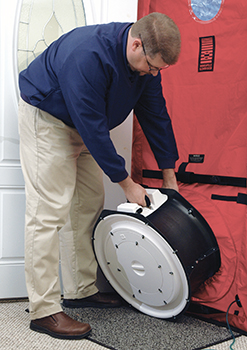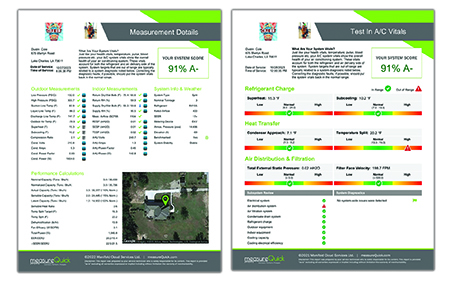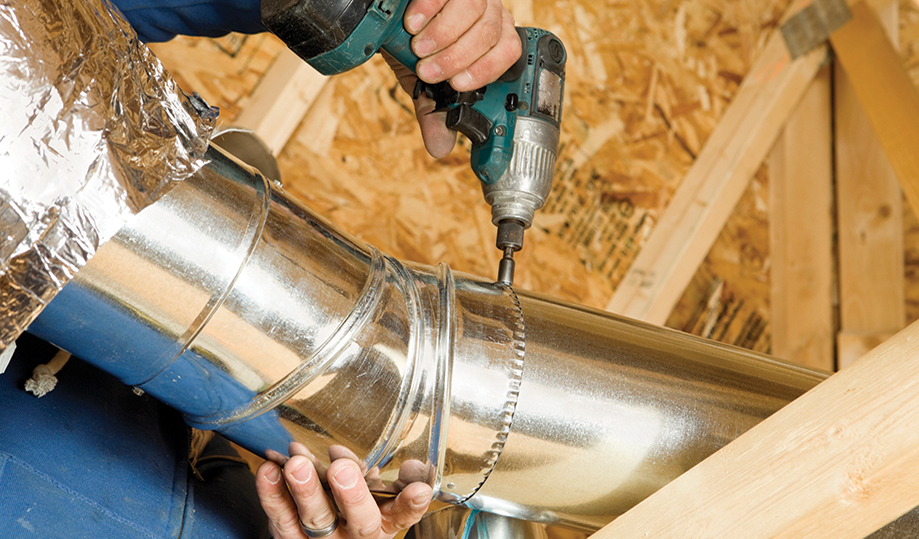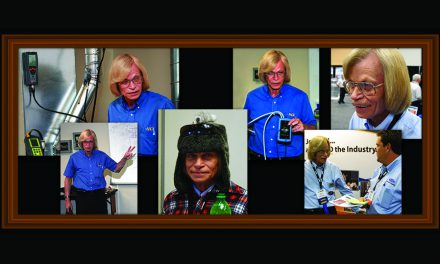Test, Test, Test
Now is the time to discover what effects – if any – the HVAC system has on the home. Let’s start with a blower door test.

- Place a probe from your precision manometer outside on the sheltered side of the home. You can slide a piece of tubing under a door seal. You will be measuring the home (+) with reference to “WRT” (-)
outside.
If it is windy, you may need to extend your time averaging or deploy other means of neutralizing the wind effects for your baseline reading. Don’t forget to write this number down or snap a picture for your reports. - Next, turn on the HVAC system. Monitor the gauge to determine if any changes occurred. Did the pressure in the house go up? If so, you likely have significant return air duct leaks.
Did the pressure go down? That means there is likely significant supply air duct leakage. Record this new number (and take a picture) and disconnect from the hose going outside. - Next, close all internal doors. Connect a hose to your manometer and place the hose into the room. You will measure the room (+) WRT to the home (-). Record each reading, documenting which doors are closed. Take pictures and add notes to your photographs.
- Finally, once all interior doors are closed, return to the hose you left outside and measure the home (+) WRT (-) outside one last time. Again, take a picture.
- Measure the existing HVAC system’s performance. You may want to run a measureQuick® report after using the Digital TruFlow® grid and Joblink® probes.
However, you can also follow your existing practices by collecting this data. That may mean measuring enthalpy changes, Delta T, refrigerant measurements, using manufacturer static pressure worksheets, etc. - Visually inspect the HVAC system. You want to thoroughly walk through the duct system, noting duct materials, routing, sizes, insulation, etc. By the way, don’t forget to take pictures.
- Visually inspect the attic/crawl spaces. Do these meet minimum insulation requirements in your market area? Is the installed insulation consistent to provide thermal balances?

Does there appear to be air sealing in critical areas such as top/bottom plates? Better yet, can you tell if air sealing was performed in other often-overlooked places, such as framed corners, ceiling/light penetrations, and drywall/wall connections?
Wrapping it Up
Following the above process, you can confirm the heating/cooling capacity delivered. You should also have a reasonable understanding of system airflow performance/deficiencies and determine if insulation deficiencies or room pressurization issues are causing unbalanced room temperatures.
For many, understanding and implementing a Home-As-A-System approach will open eyes and minds to many missed opportunities and may answer some longstanding questions.
Remember, air is powerful, and our HVAC systems are arguably the most impactful on building envelope performance when it comes to induced leakage.
Dustin Cole owns Cole Air, Inc., Lake Charles, LA. The company opened for business in 1985 and provides complete heating and cooling services. Cole is a strong proponent of High-Performance HVAC™ contracting and believes in continuous education, especially in HVACR & building performance work. He can be reached at ncilink.com/ContactMe.













Recent Comments